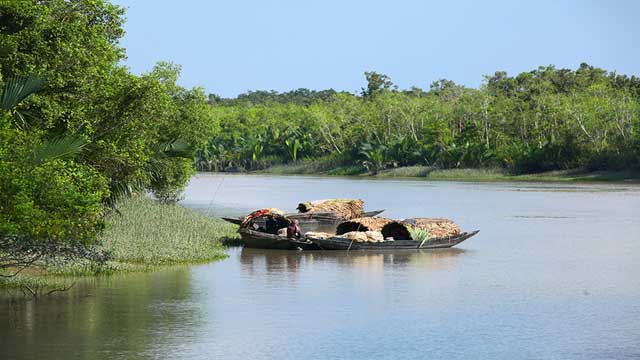Nature lovers gathered near the Sundarbans seeking forgiveness for the human atrocities against the biggest mangrove forest on earth that has for generations acted as a shield for the coastal areas.
On the occasion of Sundarbans Day, green activists on Monday staged a unique demonstration, seeking forgiveness from the forest that is a source of livelihood for many.
Bangladesh Poribesh Andolan (Bapa), Waterkeepers Bangladesh, Pashur River Waterkeeper along with other banners organized a demonstration in Sundarban’s Dangmari around 11 am.
They observed the day by seeking forgiveness for the use of fossil fuels, creating climate crisis, unplanned industrialization, shipwreck of coal-oil filled ships in Pashur River, ship waste industry and plastic pollution, killing of wildlife including tigers, deer, birds, poisoning aquatic life including dolphins, and deforestation.
“The biodiversity of Sundarbans is at risk due to human actions,” said Bapa chief Md Nur Alam.
He added that people need to step away from destroying the forest, and a sustainable environment friendly development plan needs to be adopted.
The speakers said that the Sundarbans forest has acted as a shield for the people and was now being destroyed.
They called for stopping the killing of wildlife and planned forest fires among other things to save the mangrove forest.
Sundarbans, a World Heritage site, hosts a complex network of tidal waterways. The forest presents an excellent example of ongoing ecological processes and many of its flora and fauna are unique to this region.
However, salinity in the Sundarbans is increasing due to climate change. Besides, the flow of water in the rivers and canals of the forest is decreasing gradually and several canals of the forest have been filled with silt.
Sundari trees are dying due to excessive salinity. Wildlife is also being affected by various diseases by consuming salt water. In the Sundarbans, wild animals are being hunted and people do fishing by spraying pesticides in rivers and canals which threaten the biodiversity of the Sundarbans.
According to various sources, there are 450 small and big rivers-canals in the Sundarbans. Due to lack of water flow, several small and big canal beds in the Sundarbans have been filled with silt. A variety of wild animals, including tigers and deer, leave the Sundarbans, cross canals, and enter the locality very often and lose their lives.
Muhammad Belayet Hossain, divisional forest officer (DFO) of the Sundarbans East Division, said over 20 canals in the area under the Sundarbans East Division have been filled with silt. Besides, a 30 km area of the Bhola river from Jaymoni to Das Bharani, Kharma canal and Aruarber canal has been filled.
In this situation, various demands have been raised at different times to protect the Sundarbans, including celebrating 'Sundarbans Day' nationally. There is also a demand for the formation of a separate ministry for the Sundarbans.
Executive Director of Sundarbans Academy Anwarul Qadir said that they have been demanding the formation of a separate ministry for the management of the Sundarbans to conserve the Sundarbans and improve the living standards of the people living near the forest. He is hopeful that if their demands are met, the fortunes of the forest and its people will improve.
Rafiqul Islam Khokon, executive director of 'Rupantor', said the first National Sundarbans Conference in Khulna ended on 14 February 2001 with the 'Sundarbans Declaration'.
Some 80 organizations including Rupantar, Khulna University, Bangladesh Poribesh Andolon (BAPA) jointly organized the conference.
At the conference, it was decided to observe 'Sundarbans Day' on February 14, and asked the government to observe 'Sundarbans Day' nationally.
Since 2002, Sundarbans Academy, Sundarbans Division, various press clubs and various organizations have been observing 'Sundarbans Day' on 14th February in the districts adjoining the Sundarbans.
In the eighteenth century, the area of the Sundarbans was almost double that of today. In 1878, the Sundarbans was declared a protected forest. The Unesco Commission of the United Nations declared three Sundarbans sanctuaries as World Heritage Sites in 1997.
In 2017, the government expanded the sanctuary area in the Sundarbans. Out of the total forest area of 6,01,700 hectares, now the sanctuary area is 3,17,900 hectares. Earlier it was only 1,39,700 hectares.
It has 375 species of wild animals, the Royal Bengal Tiger and other threatened species such as the estuarine crocodile, the Indian python, and the gangetic dolphins.
mj/





